In order to generate a more inclusive dataset of Pseudomonas genes mapped to putative in-paralogs and putative orthologs in other Pseudomonas species/strains, we developed a Pseudomonas Orthologous Groups classification system.
To generate ortholog groups, pair-wise DIAMOND searches were run on all genomes in the database to find reciprocal best hits (RBHs) for each gene. These analyses often resulted in multiple candidate genes for RBH status, which were narrowed down by examining the similarity between the query's flanking genes and the hit's flanking genes. If two candidate genes were directly adjacent, they where both accepted as RBHs that involve putative in-parology.
Pairwise intra-genome DIAMOND searches were also performed to acquire in-paralog information (i.e. gene duplications occurring after species divergence). If two genes in one genome were reciprocally more similar to each other than to any gene in the other genomes, the two genes were designated putative in-paralogs. Ortholog groups are built by starting with a seed gene and then adding all genes to which there is a RBH or in-paralog relationship.
Every new gene added to an ortholog group was then treated as a seed gene and the addition process was repeated until all qualifying genes had been added. The result was the development of orthologous groups, specifically generated for Pseudomonas species genomes, which can be used to sort search results.
Pseudomonas Ortholog Group POG001160
| Strain | Locus Tag | Description | Same-Strain Members | Fragment ? | |
|---|---|---|---|---|---|
| Pseudomonas aeruginosa PAO1 (Stover et al., 2000) | PA1203 |
hypothetical protein
|
2 same-strain members: PA1203 PA1926 |
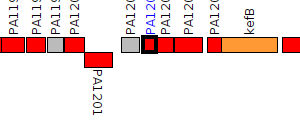
|
|
| Pseudomonas aeruginosa PAO1 (Stover et al., 2000) | PA1926 |
Uncharacterized protein
|
2 same-strain members: PA1203 PA1926 |
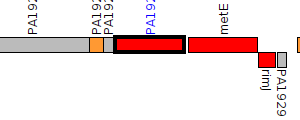
|
|
| Pseudomonas aeruginosa UCBPP-PA14 (Lee et al., 2006) | PA14_39610 |
hypothetical protein
|
2 same-strain members: PA14_39610 PA14_48750 |
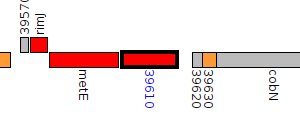
|
|
| Pseudomonas aeruginosa UCBPP-PA14 (Lee et al., 2006) | PA14_48750 |
hypothetical protein
|
2 same-strain members: PA14_39610 PA14_48750 |
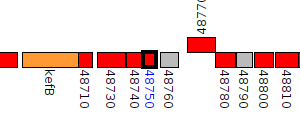
|
|
| Pseudomonas aeruginosa PA7 | PSPA7_4175 |
hypothetical protein
|
1 member |

|
|
| Pseudomonas fluorescens SBW25 | PFLU1833 |
hypothetical protein
|
2 same-strain members: PFLU1833 PFLU3408 |

|
|
| Pseudomonas fluorescens SBW25 | PFLU3408 |
hypothetical protein
|
2 same-strain members: PFLU1833 PFLU3408 |

|
|
| Pseudomonas aeruginosa LESB58 | PALES_33971 |
hypothetical protein
|
2 same-strain members: PALES_33971 PALES_41061 |
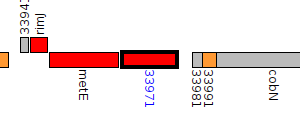
|
|
| Pseudomonas aeruginosa LESB58 | PALES_41061 |
putative redox protein
|
2 same-strain members: PALES_33971 PALES_41061 |
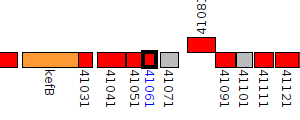
|
|
| Pseudomonas protegens Pf-5 | PFL_2783 |
hypothetical protein
|
1 member |
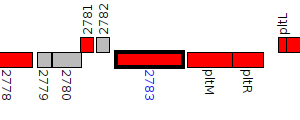
|
|
| Pseudomonas aeruginosa 19660 | Q010_02572 |
hypothetical protein
|
2 same-strain members: Q010_02572 Q010_03324 |
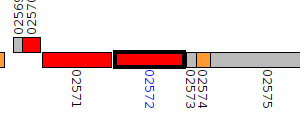
|
|
| Pseudomonas aeruginosa 19660 | Q010_03324 |
peroxiredoxin
|
2 same-strain members: Q010_02572 Q010_03324 |

|
|
| Pseudomonas aeruginosa 19BR | IAI_RS0106215 |
peroxiredoxin
|
2 same-strain members: IAI_RS0106215 IAI_RS0110030 |

|
|
| Pseudomonas aeruginosa 19BR | IAI_RS0110030 |
hypothetical protein
|
2 same-strain members: IAI_RS0106215 IAI_RS0110030 |

|
|
| Pseudomonas aeruginosa 213BR | IAK_RS0106480 |
peroxiredoxin
|
2 same-strain members: IAK_RS0106480 IAK_RS0110305 |

|
|
| Pseudomonas aeruginosa 213BR | IAK_RS0110305 |
hypothetical protein
|
2 same-strain members: IAK_RS0106480 IAK_RS0110305 |

|
|
| Pseudomonas aeruginosa 2192 | PA2G_00187 |
peroxiredoxin
|
2 same-strain members: PA2G_00187 PA2G_00964 |

|
|
| Pseudomonas aeruginosa 2192 | PA2G_00964 |
hypothetical protein
|
2 same-strain members: PA2G_00187 PA2G_00964 |

|
|
| Pseudomonas aeruginosa 3573 | AJ60_01015 |
peroxiredoxin
|
2 same-strain members: AJ60_01015 AJ60_04857 |
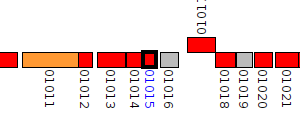
|
|
| Pseudomonas aeruginosa 3573 | AJ60_04857 |
protein involved in RimO-mediated beta-methylthiolation of ribosomal protein S12 YcaO
|
2 same-strain members: AJ60_01015 AJ60_04857 |
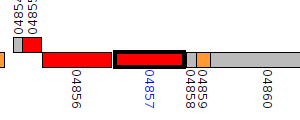
|